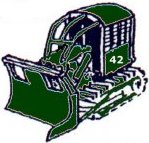 |
| History Of The Rome K/G Blade |
 |
 |
| Ernest Kissner owned and operated draglines in Lottie, Louisiana area about 75 miles west of Baton Rough. Since this type of work kept him away from home and family quite a bit, he counseled with his father-in-law, Mr. Ed Greene, who advised him that he owned more land than he could take care of by himself. Mr. Greene was willing to sell some of this land to Kissner on a long-term basis with the proviso that Kissner clear this land for pasture and croplands. Kissner purchased a bulldozer and angle blade and started attacking the heavy Louisiana jungle-like growth in the conventional manner ~ ~ that is, cutting the tree roots, pushing the trees over and dozing them out. While doing this work himself as operator, he decided there had to be a better way to do it especially on springy, ash tree thickets. After counseling his father, Mr. John Kissner, Sr. and his fater-in-law, he decided that a knife-like cutting edge attached to the bulldozer blade would be a practical solution, but fount this only worked on the smaller diameter ash and similar growth. After shearing this type of growth level with the ground, he would then have to remove his cutting edge and go back to conventional grubbing of the larger trees. One day it dawned on him that he could speed up work and save money if he could whittle larger trees down to size and then shear them off, at ground level, leaving the roots in place. From this idea he developed the now famous "Stinger" or splitter which he attached the the leading edge of his dozer blade and started expermenting. The combination of a splitter and shearing blade reduced the work, time of operation, and drastically reduced the cost. He also discovered he could use the same tool for windrowing the cut material thereby saving the time required to change from the cutting blade back to the conventional dozer or rake he had previously used for windrowing. He also found by cutting the trees flush with the ground he could windrow this material with less dirt going into the windrows than by conventional methods. Finding that their original idea substantially reduced the cost of land clearing, the parties associated with the development filed for patents. As the word spread about the cost reducing tractor attachments, Kissner was deluged with request from pipliners, highway contractors and land developers to clear land for them on a contract basis. It soon became apparent that he could not take care of all this work, even with a sizable fleet of tractors. He, therefore, started manufacturing attachments consisting of cutting edge, stinger and guide bars which he sold to individual contractors. Faced with the constantly growing requirements for larger facilities. and little experience in manufacturing he sought out an established firm, The Rome Plow Company of Cedertown, Georgia, to manufacture and distribute the now patented Rome K/G Blade on a royalty basis. Since signing the agreement in October, 1957, thousands of the Rome K/G Blades are clearing land all over the world. To our knowledge, there is nothing else that can touch this unit for quick and economical land clearing that at the same time leaves the top soil in place and eliminates the problem of stump holes and root balls. With this simple but exceedingly important tool the unproductive jungles of the earth are being prepared for crops to feed the ever increasing population of the world. In Vietnam the U. S. Army is using Rome K/G Blades to clear out enemy redoubts and ambush sites and to turn jungle masses into productive crop lands. |
| Click On Image |
| To View Larger One |
|
|
|||||